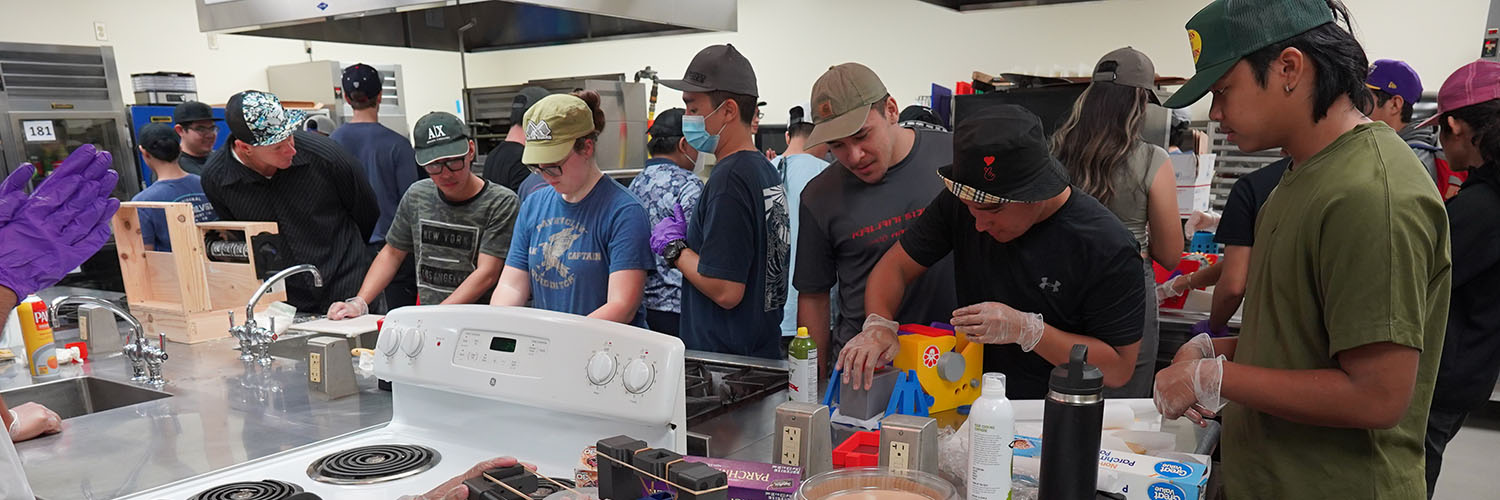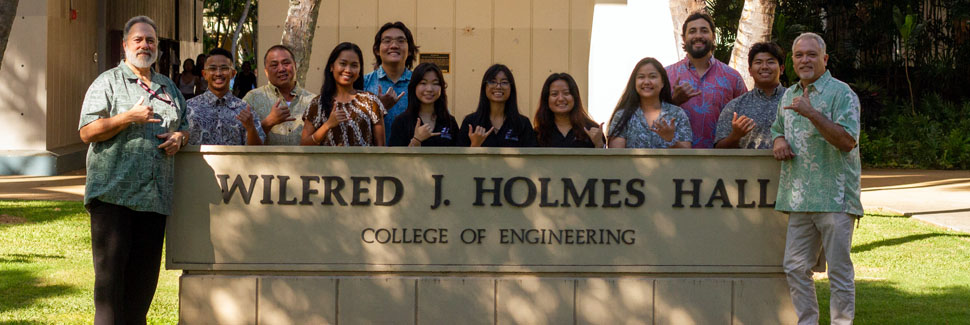
The Great Mechanical Engineering Bake-Off! Students test designs with dough
University of Hawaiʻi at Mānoa College of Engineering students had a real-world taste of manufacturing processes in the sweetest way possible. Through a project led by Assistant Professor Tyler Ray and in collaboration with FSHN Instructor Lara Hackney in the Department of Human Nutrition, Food and Animal Sciences, nine teams of five students were tasked to produce sugar cookies bearing the UH logo using self-designed production systems.
After weeks of designing and planning, the students finally put their systems to the test in a bake-off, seeing which team could produce the most number of high-quality cookies in the shortest amount of time.
“I’m a firm believer in project-based learning,” said Ray. “By challenging our students to design and build a system to make sugar cookies with the UH logo, we’re not only teaching them about traditional manufacturing processes but also fostering creativity and problem-solving skills that are critical to their success as engineers.”
In a bid to promote creativity, ingenuity and sustainable design, the project required students to work within the constraints of a $20 budget for their cookie rolling systems, including the 3D-printed UH logo cookie cutters and any additional components, such as the system’s frame. By imposing this budget restriction, Ray sought to inspire students to focus on low-resource engineering and creative problem-solving, emphasizing the importance of resource management and developing critical skills necessary for the creation of sustainable and cost-effective engineering designs.
Most teams created machines that flattened the dough similar to a pasta roller, simultaneously imprinting the dough with the UH logo. Others developed stamping systems to cut and imprint cookies, while another pushed an intricate system in a manner akin to a cookie roller across a large slab of dough to produce a greater yield.
“Getting this hands-on experience and seeing how a design comes to life is very useful to learn about different manufacturing processes and what it actually takes to get from a computer design to an actual product,” said Anna Kiraly, a junior majoring in mechanical engineering. “In the simulations we design, everything works fine, but when we get to the point where it needs to work in real life, the outcome is very different from what we expect.”
Eyes on food security
In December 2022, Ray and another class of students created custom 3D-printed chocolate molds for local chocolate company, Choco leʻa. Building on the food theme, Ray’s cookie production project further expanded the relationship between food and engineering machines to assist with food security.
Food insecurity, a silent epidemic plaguing college campuses, has far-reaching consequences for students’ academic performance, health, and overall well-being. Prior to the pandemic, an alarming 30% of college students faced food insecurity at some point in their academic careers, with significant racial and ethnic disparities further exacerbating the issue. The recent student design competition, along with other food-centered initiatives, aims to focus students’ attention on the critical importance of food production and access. By engaging with real-world issues like food insecurity and fostering a deeper understanding of food access, these competitions are essential for introducing the next generation of engineering thought leaders to key problems they will need to address.
Kiraly said, “This project and what we’ve been learning so far in this class is basically reinventing food production and manufacturing in a way that takes into account the environment of a place. It could be that the place doesn’t have good food accessibility, so these are the types of machines that you could use at a low budget for a good output.”
Collaborating for the Future
This student competition project exemplifies the importance of interdisciplinary collaboration at UH Mānoa, bringing together the Department of Mechanical Engineering and the Department of Human Nutrition, Food and Animal Sciences. By uniting these distinct fields of study, the project has opened the mechanical engineering students’ minds to a wide array of exciting research and training opportunities on campus, emphasizing the synergy that can be achieved through such collaborative efforts.
Ray said, “Interdisciplinary collaboration is the driving force behind groundbreaking innovation, and I am passionate about promoting it in both my teaching and research. My work in biomedical research—bridging material science, advanced manufacturing, and wearable technology—has demonstrated the immense potential of combining diverse fields to create solutions to challenging problems in clinical care. By fostering interdisciplinary collaboration, we empower students to think beyond traditional boundaries, enabling them to tackle complex challenges and develop transformative solutions that can shape the future.”
The collaborative approach to the project expanded the students’ perspectives and highlighted the potential of interdisciplinary teamwork to drive innovation and generate real-world solutions. By bridging the gap between engineering and food sciences, the project has fostered a new generation of engineers who are keen on utilizing their skills to address pressing global challenges such as food security and sustainable food production.



